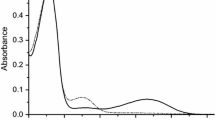Abstract
The transport of branched-chain amino acids was characterized in intact cells of Corynebacterium glutamicum ATCC 13032. Uptake and accumulation of these amino acids occur via a common specific carrier with slightly different affiniteis for each substrate (K m[Ile]=5.4 μM, K m[Leu]=9.0 μM, K m[Val]=9.5 μM). The maximal uptake rates for all three substrates were very similar (0.94–1.30 nmol/mg dw · min). The optimum of amino acid uptake was at pH 8.5 and the activation energy was determined to be 80 kJ/mol. The transport activity showed a marked dependence on the presence of Na+ ions and on the membrane potential, but was independent of an existing proton gradient. It is concluded, that uptake of branched-chain amino acid transport proceeds via a secondary active Na+-coupled symport mechanism.
Similar content being viewed by others
Abbreviations
- CCCP:
-
Carboxyl cyanide m-chlorophenylhydrazone
- dw:
-
dry weight
- MES:
-
2[N-morpholino]ethanesulfonic acid
- mon:
-
monensin
- nig:
-
nigericin
- TPP:
-
tetraphenylphosphonium bromide
- Tris:
-
tris[hydroxymethyl]aminomethane
- val:
-
valinomycin
References
Anraku Y (1978) Active transport of amino acids. In: Rosen BP (ed). Bacterial transport. Dekker, New York, pp 171–219
Araki K, Oka T, Nakayama K (1973) Na+-dependent transport of amino acids and its significance for growth of a lysine-producing bacterium. Agr Biol Chem 37:1357–1366
Cleland WW (1970) Steady state kinetics. In: Boyer PD (ed) The enzymes, 3rd ed, vol 2. Academic Press, New York, pp 1–65
Crane RK (1965) Na+ dependent transport in the intestine and other animals tissues. Fed Proc 24:1000–1006
Crane RK, Forstner G, Eichholz A (1965) Studies on the mechanism of the intestinal absorption of sugars. X. An effect of the Na+ concentration of the apparent Michaelis constants for intestinal sugar transport, in vitro. Biochim Biophys Acta 109:467–477
Dimroth P, Thomer A (1986) Citrate transport in Klebsiella pneumoniae. Biol Chem Hoppe-Seyler 367:813–823
Dixon M (1953) The determination of enzyme inhibitor constants. Biochem J 55:170–171
Driessen JM, de Jong S, Konings WN (1987) Transport of branched-chain amino acids in membrane vesicles of Streptococcus cremoris. J Bacteriol 169:5193–5200
Driessen JM, Ubbink-Kok T, Konings WN (1988) Amino acid transport of membrane vesicles of an obligate anaerobic bacterium. Clostridium acetobutylicum. J Bacteriol 170:817–820
Guardiola J, De Felice M, Klopotowski T, Iaccarino M (1974) Multiplicity of isoleucine, leucine, and valine transport systems in Escherichia coli K-12. J Bacteriol 117:382–392
Higgins CF, Ardeshir F, Ames GF-L (1982) Active transport of amino acids in bacteria. In: Martonosi AN (ed) Membranes and transport, vol 2. Plenum Press, New York London, pp 89–94
Hoshino T (1979) Transport systems for branched-chain amino acids in Pseudomonas aeruginosa. J Bacteriol 137:73–81
Hoshino T, Kageyama M (1979) Sodium-dependent transport of l-leucine in membrane vesicles prepared from Pseudomonas aeruginosa. J Bacteriol 137:73–81
Hoshino T, Kageyama M (1982) Mutational separation of transport systems for branched-chain amino acids in Pseudomonas aeruginosa. J Bacteriol 151:520–628
Johnson CL, Cha Y-A, Stern JR (1975) Citrate uptake in membrane vesicles of Klebsiella aerogenes. J Bacteriol 121:682–687
Kashket E (1985) The proton motive force in bacteria: A critical assessment of methods. Ann Rev Microbiol 39:219–242
Kinoshita S (1985) Glutamic acid bacteria. In: Demain AL, Solomon NA (eds) Biology of industrial microorganisms. Benjamin/Cummings, London, pp 114–142
Kiritani K, Ohnishi K (1977) Repression and inhibition of transport systems for branched-chain amino acids in Salmonella typhimurium. J Bacteriol 129:589–598
Klingenberg M, Pfaff E (1967) Means of terminating reactions. In: Colowick SP, Kaplan NO, Estabrook RW, Pullman ME (eds) Methods in enzymology, vol 10. Academic Press, New York, pp 680–684
Konings WN, Freese E (1972) Amino acid transport in membrane vesicles of Bacillus subtilis. J Biol Chem 247:2408–2418
Landick R, Oxender DL, Ames GFL (1984) Bacterial amino acid transport systems. In: Martonosi AN (ed) The enzymes of biological membranes, 2nd ed. Plenum Press, New York, pp 577–615
Lolkema K, Hellingwerf KJ, Konings WN (1982) The effect of “probe binding” on the quantitative determination of the proton-motive force in bacteria. Biochim Biophys Acta 681:85–94
Luntz MG, Zhdanova NI, Bourd GI (1986) Transport and excretion of l-lysine in Corynebacterium glutamicum. J Gen Microbiol 132:2137–2146
Lyon I, Crane RK (1966) Studies on transmural potentials in vitro in relation to intestinal absorption. I. Apparent Michaelis constants for Na+-dependent sugar transport. Biochim Biophys Acta 112:278–291
Niiya S, Yamasaki K, Wilson TH, Tsuchiya T (1982) Altered cation coupling to melibiose transport in mutants of Escherichia coli. J Biol Chem 257:8902–8906
Rosen BP, Kashket ER (1978) Energetics of active transport. In: Rosen BP (ed) Bacterial transport. Dekker, New York, pp 559–621
Rottenberg H (1979) The measurement of membrane potential and pH in cells, organelles, and vesicles. In: Colowick SP, Kaplan NO, Fleischer S, Packer L (eds) Methods in enzymology, vol 55. Academic Press, New York, pp 547–569
Shiio I, Miyajima R, Kashima N (1973) Na+-dependent transport of threonine in Brevibacterium flavum. J Biochem 73:1185–1193
Tsuchiya T, Wilson TH (1978) Cation-sugar cotransport in the melibiose transport system of Escherichia coli. Membr Biochem 2:63–77
Wilkerson LS, Eagon RG (1974) Effect of sodium on the transport and utilization of citric acid by aerobacter (Enterobacter) aerogenes. J Bacteriol 120:121–124
Wood JM (1975) Leucine transport in Escherichia coli: the resolution of multiple transport systems and their coupling to metabolic energy. J Biol Chem 250:4477–4485
Zaritsky A, Kihara M, Macnab R (1981) Measurement of membrane potential in Bacillus subtilis: A comparison of lipophilic cations, rubidium ion, and a cyanine dye as probes. J Membr Biol 63:215–231
Author information
Authors and Affiliations
Rights and permissions
About this article
Cite this article
Ebbighausen, H., Weil, B. & Krämer, R. Transport of branched-chain amino acids in Corynebacterium glutamicum . Arch. Microbiol. 151, 238–244 (1989). https://doi.org/10.1007/BF00413136
Received:
Accepted:
Issue Date:
DOI: https://doi.org/10.1007/BF00413136




